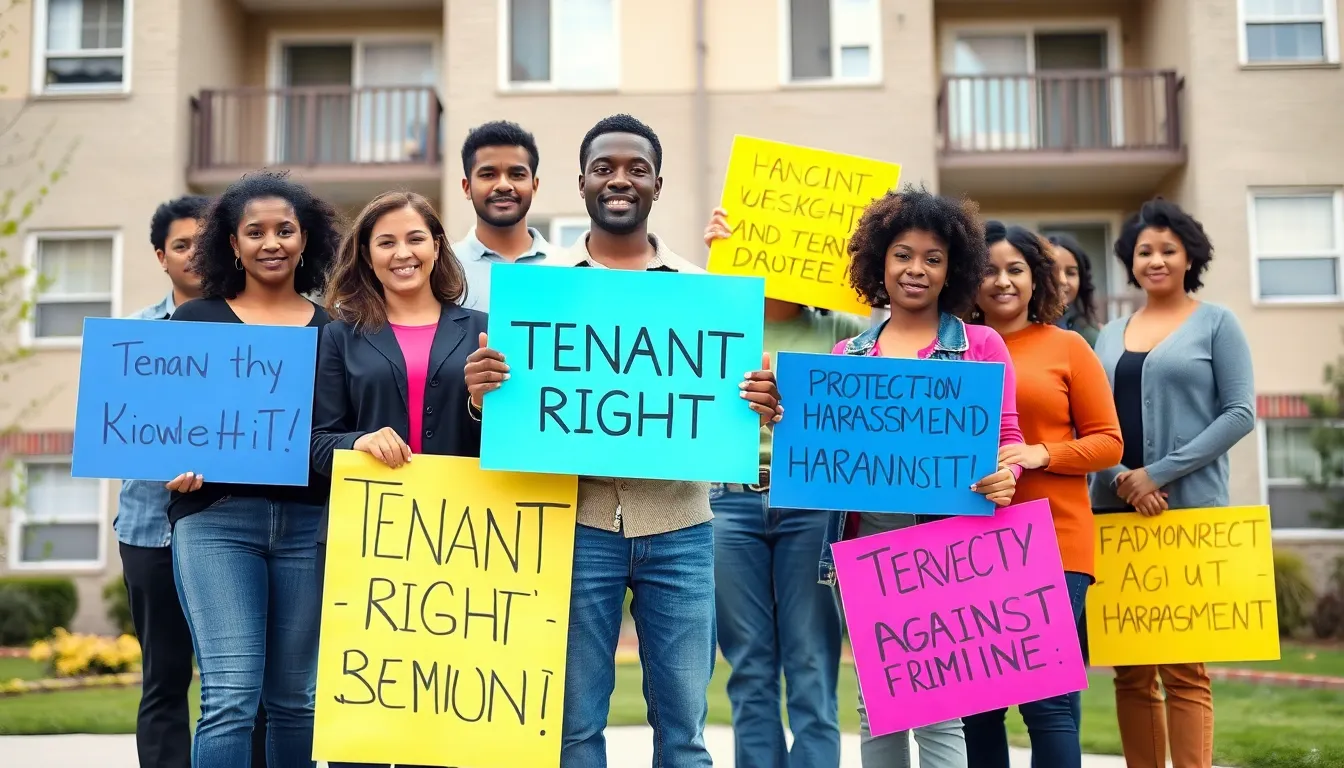Navigating the world of renting can feel like a high-stakes game of Monopoly, where one wrong move could land you in the slammer—or worse, stuck with a landlord who thinks “tenant harassment” is just a fancy term for friendly banter. But fear not! Tenant harassment laws exist to protect renters from the not-so-friendly antics of their landlords.
These laws are like a superhero cape for tenants, swooping in to save the day when landlords overstep their bounds. From unwanted visits to creepy phone calls, understanding these rights can empower renters to stand tall and say, “Not today!” With a sprinkle of humor and a dash of legal know-how, this article will unravel the complexities of tenant harassment laws, ensuring that every renter knows how to keep their living space a harassment-free zone.
Table of Contents
ToggleOverview of Tenant Harassment Laws
Tenant harassment laws provide essential protections for renters facing inappropriate conduct from landlords. Various actions typically qualify as harassment, including unwanted visits, excessive phone calls, intimidation, or making threats. Many states enforce specific statutes to address these behaviors, reinforcing tenants’ rights to a peaceful living environment.
Legal frameworks may vary by state, but most recognize certain tenants’ rights. Renters often enjoy rights against retaliation if they report harassment or seek legal recourse. In situations where landlords engage in discriminatory practices, such as racial or gender-based harassment, laws under the Fair Housing Act apply.
Documentation plays a vital role in tenant harassment cases. Collecting evidence, like emails, notes, or recordings of interactions, strengthens a tenant’s position. Local courts may require such documentation for protective orders or other legal actions.
Tenants may file complaints with regulatory agencies if landlords persist in harassing behavior. Agencies often investigate complaints, ensuring landlords adhere to legal standards. Mediating disputes may occur through local organizations, offering alternatives to courtroom litigation.
If harassment escalates, tenants might seek a restraining order against landlords. Courts typically grant such orders based on the severity of the harassment and evidence presented. Engaging legal counsel often proves beneficial for navigating complicated situations.
Overall, tenant harassment laws exist to safeguard renters. Understanding these laws empowers tenants to stand up against harassment and maintain their rights. Ensuring a harassment-free living space remains a fundamental aspect of leasing agreements across the country.
Types of Tenant Harassment

Various actions constitute tenant harassment. These actions can significantly impact a renter’s living experience and rights.
Verbal Harassment
Verbal harassment occurs when a landlord uses threatening or abusive language towards a tenant. Communication may involve yelling, insults, or intimidation tactics. Landlords may also attempt to coerce tenants through manipulation or constant criticism. This behavior creates a hostile living environment and undermines tenant dignity. Documenting such incidents is crucial, as these records serve as evidence if legal action becomes necessary. Courts generally consider persistent verbal abuse as harassment, particularly if it interferes with a tenant’s enjoyment of their home.
Physical Harassment
Physical harassment includes any unwanted physical contact or invasion of personal space by a landlord. This may involve entering a tenant’s home without permission or using physical force to intimidate. Occupants feel threatened when landlords engage in aggressive actions, such as blocking exits or making unwanted physical advances. Feelings of safety are essential for all tenants. Consistent documentation of these incidents is vital, as it helps establish a pattern of abusive behavior. Legal repercussions can follow physical harassment claims, making it important for tenants to understand their rights and options for recourse.
Legal Protections for Tenants
Tenants enjoy multiple legal protections against harassment from landlords. Understanding these laws is crucial for maintaining a safe living environment.
Federal Laws
The Fair Housing Act offers foundational protections against discrimination and harassment in housing. It applies to all rental properties and prohibits actions based on race, color, religion, sex, national origin, familial status, and disability. Furthermore, victims of harassment can file complaints with the Department of Housing and Urban Development (HUD) within one year of the alleged violation. Legal remedies may include monetary damages, injunctions against the landlord, or changes to the rental agreement.
State-Specific Laws
State laws often enhance federal protections for tenants. Some jurisdictions provide additional safeguards against retaliatory eviction after tenants report harassment. For instance, California explicitly protects tenants who complain about housing conditions or report landlord misconduct. Certain states define harassment more broadly, including actions like frequent unwanted visits or surveillance. Each state’s laws may vary significantly, so researching local statutes is necessary. Knowledge of these state-specific laws enables tenants to take informed actions against harassment and hold landlords accountable effectively.
Reporting and Documenting Harassment
Reporting harassment entails a methodical approach. First, collect all pertinent details about the incidents. This includes dates, times, and descriptions of what occurred. Specific instances of verbal abuse or unauthorized entry should be noted for accuracy.
Document interactions with the landlord as they happen. Keep a written log of conversations, text messages, or emails that reflect harassment. Such evidence often proves invaluable in legal proceedings. If possible, gather witness statements from neighbors or other tenants who may have observed the behavior. Clear documentation strengthens a tenant’s ability to demonstrate a pattern of harassment.
For formal reporting, tenants should contact local housing authorities or tenant advocacy groups. Many organizations provide resources to assist individuals in navigating the reporting process. Filing a complaint with these entities can initiate an investigation into the landlord’s actions.
Consider involving legal counsel if harassment escalates or becomes particularly severe. Attorneys specialize in tenant rights and can advise on the most effective strategies. They may assist in preparing documentation and represent tenants in negotiations or court appearances.
Tenants also have the option to pursue mediation as a means to resolve disputes without escalating to legal action. Engaging a mediator can clarify issues and facilitate a constructive dialogue between parties. Mediation often provides a less confrontational route to achieving a resolution.
Moreover, in critical situations, seeking a restraining order may become necessary. Courts typically require substantial evidence of harassment before granting such orders. Protecting personal safety through legal measures is essential when all other avenues have been exhausted.
Consequences for Landlords
Landlords face significant consequences for engaging in tenant harassment. Legal actions may include civil lawsuits, where tenants seek damages for emotional distress and other losses. Courts often award compensation based on the severity of the harassment and the tenant’s documented experiences.
Regulatory agencies may impose fines or penalties on landlords who violate tenant harassment laws. These penalties can vary by jurisdiction but typically serve to deter further misconduct. Some states offer a robust framework for sanctions, emphasizing the importance of protecting tenants’ rights.
Eviction proceedings can also be impacted by a landlord’s harassment. Courts typically look unfavorably on landlords who attempt to retaliate against tenants for reporting harassment. Legal provisions prevent landlords from evicting tenants solely based on complaints about harassment, reinforcing tenant protections.
Restraining orders represent a more serious repercussion for landlords. These judicial orders may prohibit landlords from coming into contact with the tenant, greatly restricting their actions. Additionally, violating a restraining order can lead to criminal charges, further complicating a landlord’s legal standing.
Professional licenses may come under scrutiny for landlords reported for harassment. In some cases, leasing agents or property managers risk losing their licenses if found guilty of repeated harassment offenses. Such measures underscore the accountability landlords face within the industry.
Tenant advocacy groups often play a key role in educating tenants about their rights and encouraging them to report harassment. They help tenants navigate the complaint process and seek justice for their experiences. Through awareness and action, landlords may face not only legal consequences but also damage to their reputation within the community.
Tenant harassment laws are vital for ensuring a safe and respectful living environment. By understanding their rights and the protections available, tenants can navigate challenging situations with confidence. Documenting incidents and seeking assistance from local housing authorities or advocacy groups can empower renters to effectively address harassment.
Landlords must be held accountable for their actions, and tenants should never hesitate to report inappropriate behavior. With the right knowledge and resources, tenants can take proactive steps to protect themselves and maintain their dignity in their homes. Ultimately, fostering awareness of these laws contributes to a fairer rental landscape for everyone involved.







